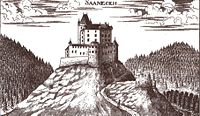Cosmas von Graben


Cosmas von Graben, Burgrave von Sannegg , also Kosmas von Graben , († end of May 1479 ) was a nobleman in the Cillic and Habsburg service who lived and worked during the 15th century.
biography
origin
Cosmas, also Kosmas, von Graben came from the Sommeregger line of the Lords of Graben , a noble family from the Meinhardin family , which reached its heyday in the 15th century. His parents were Andreas von Graben zu Sommeregg and Barbara von Hallegg (Hallecker), daughter of the imperial council and administrator of the main team of Carinthia, Burgrave Jörg von Hallegg (Hallecker). One of his brothers was the Görzische Reichsverweser Virgil von Graben , influential councilor of the Görz counts and Emperor Maximilians , one of his nephews Ladislaus Prager , Hereditary Marshal of Carinthia and chamberlain of Emperor Friedrich III.
Act
Around 1460 Cosmas von Graben was appointed imperial burgrave and caretaker at Sannegg Castle (Grad Žovnek) and the associated splendor in the Lower Styrian Sanntal on the Savinja . As administrator on Sanneck he was also confronted in the fighting with the invaded Turkish cavalry hordes. 1467 he was by Emperor Friedrich III. charged with the military security of the Styrian border near Fürstenfeld .
When the invaded Turks plundered parts of the duchies of Carniola, Styria and Carinthia on their raids in 1472, Von Graben, along with Georg von Gera and Leonhard Rauber, stood out as one of the three nobles who victoriously fought the Turks in the duchies mentioned. In this source his original descent from Carniola is expressly noted, that of Graben Castle near Rudolfswerth in Niederkrain. In the following year, at the meeting at Vziethal (?), Where numerous members of the nobility fell or were taken prisoner by the Turks, some of them managed to escape, including the several times wounded Cosmas von Graben. A chivalrous manner was attested to him in these fights .
In 1478 Cosmas von Graben was by Friedrich III. enfeoffed with Eppenstein Castle , where he succeeded Georg von Kainach . In the year of his death in 1479, he was succeeded by Andre von Teuffenbach . In the files of Friedrich III. The name von Grabens is used at regular intervals, be it in his function as imperial burgrave on Sannegg or elsewhere.
On June 2, 1479, probably shortly after the death of von Graben, Jakob Schratt received the Schönegkh [Sannegg, Sanneck] castle together with races and splendors like the same castle as Cosmas von Graben had previously had .
Individual evidence
- ↑ Johann Weichard Freiherr von Valvasor : The honor of the Hertzogthums Crain : that is, true, thorough, and quite proper evidence and condition of this Roman-Keyserlichen wonderful hereditary land. Laybach (Ljubljana) 1689
- ^ Contributions to the study of Styrian history, Volume 34
- ^ History of Krain from the earliest times up to the year 1813, by August Dimitz, p. 286
- ^ History of the Duchy of Styria, Volumes 7–8. From Albert von Muchar. Page 88
- ^ Historical-topographical lexicon of Steyermark. From Carl Schmitz
- ↑ Monumenta habsburgica: Collection of acts and letters to ..., Volume 2. By Joseph Chmel, Karl Fr. W. Lanz, Kaiserl. Academy of Science
- ↑ Description of the Duchy of Steyermark, Volume 2 . By Aquiline Julius Caesar , page 275
- ↑ Monumenta habsburgica: Collection of acts and letters to ..., Volume 2. By Joseph Chmel, Karl Fr. W. Lanz, Kaiserl. Academy of Science. Pages 707 and 767
- ^ Archive for customer of Austrian historical sources, Volume 2. By Kaiserl. Academy of Sciences in Vienna. Historical commission. Pages 476 and 477
| personal data | |
|---|---|
| SURNAME | Dig, Cosmas of |
| ALTERNATIVE NAMES | Dig, Kosmas of |
| BRIEF DESCRIPTION | Burgrave of Sannegg, Austrian military |
| DATE OF BIRTH | 15th century |
| PLACE OF BIRTH | Sommeregg Castle |
| DATE OF DEATH | May 1479 |
| Place of death | uncertain: Sannegg Castle, Carinthia, Austria |